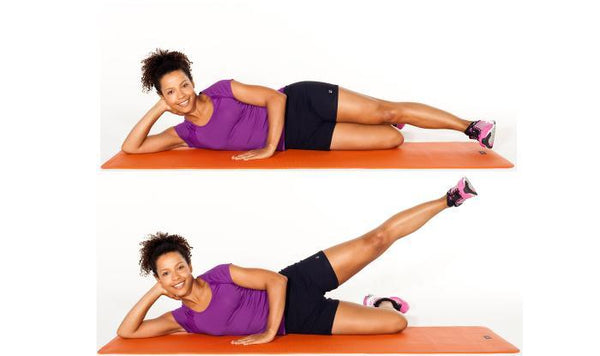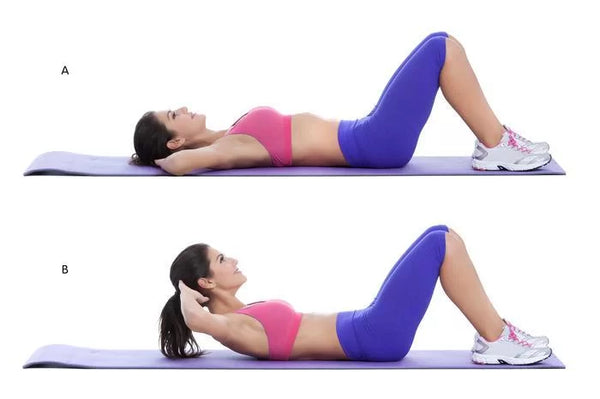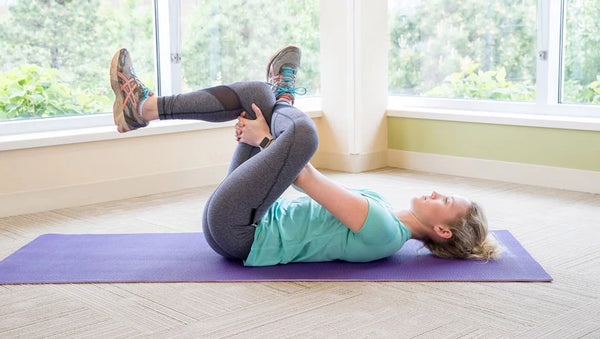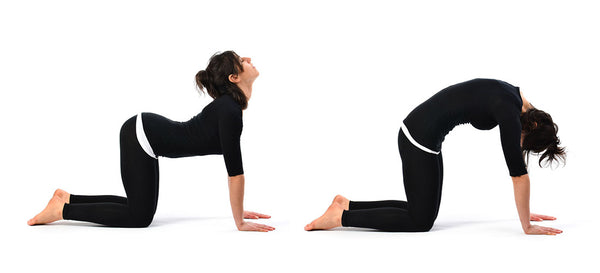
15 Exercises for Lower Back Pain
Share
Whether it’s acute or chronic, lower back pain is an extremely common problem among adults. Statistics show that back pain is considered severe, very severe, or even the worst pain possible by 36% of adults in the US. Research suggests that 80% of adults will experience some form of back pain. With this, there’s a good chance that you’ll experience low back pain at some point in your lifetime.
Whilst it can be a serious and debilitating condition, you can perform a variety of stretches and strengthening exercises. Each one is designed to improve mobility and provide some much-needed relief.
We’ve teamed up with Kelly Stone, a well-known athlete and Doctor of Physical therapy to bring you the best lower back pain exercises to combat some of the common issues you may have experienced. With an extensive background in competitive gymnastics and swimming, Kelly knows only too well what it takes to navigate the competitive field in terms of performance and injury prevention.
While completing her Doctorate in Physical Therapy from the University of Florida, she developed extensive knowledge in functional weight training, gymnastics movements, and Olympic lifting. Kelly is passionate about the biomechanics of movement, injury prevention, and helping others to live pain-free. Because of this, we know that she is the ideal person to help us with some lower back pain exercises.
Exercise is considered a highly effective method to relieve back pain, with a sedentary lifestyle and bed rest often a contributing factor. With the help of Kelly, we’ve shared some science-backed stretches and lower back muscle pain exercises to improve your symptoms and get you moving again. Let’s look at them in detail below!
The Best Exercises for Lower Back Pain
Regular exercise therapy is considered to be one of the most effective ways to improve lower back pain. Lumbar stabilization exercises help to improve trunk stability and coordination in the affected areas.
The exercises below are easy to perform and require minimal equipment. They should form part of your daily lower back rehabilitation exercise routine.
Cobra Supermans
The Cobra Superman exercise is great for relieving lower back pain. It’s a strength and stability movement primarily designed to strengthen your lower back through active extension. This can help to stabilize the spine and alleviate back pain.
The Cobra Superman exercise is great for those people who can perform active back ranges of motion with little to no pain. Therefore, it's more of a preventative strengthening lower back exercise.
Building a stronger lower back helps you maintain a good posture which can often be an underlying cause of pain.
- Lay on the ground with your head facing the floor. Extend your leg behind you, placing your elbows or hands close to your shoulders. Your arms should be tucked close into your body.
- Keep the elbows against the floor. Take a deep breath in and lift your upper body off the ground by extending your back. Assume a cobra-like position with your head facing forward.
- Move back and forth in and out of the cobra position as needed.
- As you come back into the starting position, bring your arms forward into a Superman position.
- Raise your arms and legs off the ground while keeping them straight to come into a Superman pose.
- Repeat the same sequence, coming into a cobra position before assuming the Superman pose.
*To increase the difficulty, press through your hands and come further up into a full cobra position
*Avoid moving too quickly or failing to engage the back muscles in the top positions.
- Kelly's Suggested Programing — 2-3 sets x 8-12 repetitions.
Glute Bridges
Glute bridges are a great way to relieve spinal pressure and improve glute activation. They help to strengthen the muscles in your hamstrings and glutes which come together to make up your posterior chain. Alongside this, then strengthen the deep core muscles which help to provide stability to support the lower back during movement, alleviating pain.
These can help to keep your body upright when sitting, loosen tight hip flexors, and improve lower back pain.
- Assume a prone position with your back against the mat. Bend your knees until your legs are at a 90-degree position. Your feet should be flat on the floor.
- Bring your pelvis backward into the floor. Check that your pelvis and lower back are both in contact with the floor.
- Push your feet into the ground and tense your glutes. Take a deep breath and engage your core muscles.
- Drive through your heels and elevate your pelvis off the ground until your hips are in line with your shoulders and knees.
- Briefly hold the top position for two to three seconds, maintaining core engagement at all times.
- Exhale as you lower back to the starting position.
*Avoid moving too quickly, keep your core engaged, and maintain a pain-free range.
*Add a resistance band or a foam roller to progress the difficulty. The band can be attached around the feet and knees to add resistance. The foam roller can be placed in between your knees, allowing you to squeeze your adductor muscles as you perform the glute bridge.
- Kelly's Suggested Programing — 2-3 sets x 8-12 repetitions.
Single-Leg Glute Bridge Exercise
The single-leg glute bridge exercise uses the same movement pattern as the normal glute bridge but performs it with one leg. These help to strengthen the muscles in the glutes, hamstrings, and core. This helps to provide stability to prevent and alleviate back pain.
The single-leg movement pattern provides a further challenge to the glutes, hamstrings, back, and core muscles. This can provide additional stability benefits.
- Start by laying on your back with your knees bent to 90 degrees. Your feet should be flat on the floor.
- Lift one leg until it's in line with the bent knee. Rotate your pelvis back into the floor and engage your core muscles.
- Squeeze your glutes and drive through your bottom foot, elevating your pelvis to the ceiling. Hold the top position for 2-3 seconds before returning to the starting position.
- Change the legs around and perform the same movement pattern.
*Common mistakes include moving too quickly, over-rotating your pelvis, and not keeping your core engaged.
*Increase the difficulty by adding a resistance band or adding a weight to the glute-bridge position.
- Kelly's Suggested Programing — 2-3 sets x 8-12 repetitions.
Kettlebell Plank Pull-Through Exercise
The kettlebell plank pull-through exercise strengthens the deep core muscles, lower back, obliques, hip flexors, and shoulder muscles. It’s more of a strength-building lower-back exercise to improve overall movement tolerance. It primarily targets the anti-rotational stability of the spine. This is important to include as a lot of our daily movements involve different amounts of rotation.
- Place a kettlebell on the left side of your body. Place both hands on the ground in front of the kettlebell in a shoulder-width position. Bring your legs back to come into a plank hold position with a straight body.
- Inhale and engage your core. Reach under your body with your right hand, grab the kettlebell, and pull it across to the right side, and return your hand to the same position.
- Grab the kettlebell with the opposite hand and perform the opposite movement pattern.
- The main goal is to prevent the pelvis from rotating while bringing the kettlebell across.
*Common mistakes include allowing the pelvis to rotate or performing the movement too quickly.
*Increase the difficulty by using a heavier kettlebell.
- Kelly's Suggested Programing — 2-3 sets x 10-20 repetitions in each direction.
Dead Bug Crunch Exercise
The Dead Bug crunch exercise is an advanced core stability movement that progresses the normal dead bug movement. It helps to train our body to provide dynamic core stabilization while our limbs are moving. Better dynamic stabilization can help reduce back pain and prevent future episodes.
- Lay on your back with a foam roller in your hands. Lift one leg and pin the foam roller between your knee and elbow. These should be done using the same side. Inhale and engage your core.
- While holding the foam roller position, lift the opposite knee and arm. Extend each of them back into a straight line before bringing them inwards to a crunch position. Press your knee and elbow together.
- Move the foam roller to the opposite side and perform the same movement pattern discussed above.
*Common mistakes include moving too quickly, not keeping the core engaged, or using a painful range of motion.
*Decrease the difficulty be performing partial ranges of motion.
*Increase the difficulty by adding a weight to the moving hand.
- Kelly's Suggested Programing — 2-3 sets x 8-12 repetitions.
Lying Lateral Raises

Image Source: Origin Bio
Your hip abductor muscles raise your legs sideways, away from your body. Alongside this, they help to support your pelvis when standing to one side.
Weak hip abductors can lead to poor balance and mobility, causing lower back pain. Lying lateral raises are a great way to train them.
- Lay on one side with your lower leg slightly bent.
- Take a deep breath in and engage your core.
- Raise your top leg to the ceiling whilst keeping the rest of your body still.
- Pause briefly at the top position and exhale as you return to the start.
- Repeat for the required number of repetitions then switch sides.
Rehabilitative Exercises for Lower Back Injuries
These three back injury exercises should form the backbone of your back rehabilitation plan alongside regular stretches and light cardiovascular work.
More commonly known as the ‘McGill big 3’, these back injury rehab exercises can help to improve pain and function in those suffering from lower back pain.
Knee Side Planks
Side bridges work your transverse abdominals and multifidus. These lateral core muscles work together with your front core and back core muscles to stabilize the spine and prevent back pain. They help prevent shear movement which can place extra stress on your lower back.
Training these muscles with knee side planks can help to put less stress on the lumbar spine region when experiencing back pain.
- Lay on your side with your right elbow under your shoulder. It can also be done on your hand with your elbow extended.
- Ensure your knees are slightly bent and stacked together. They should be close to being in line with your hips and shoulders.
- Engage your core and take a deep breath.
- While supporting your torso, bring your hips off the ground. Your spine and pelvis should be in a neutral position. Make a straight line from your knees through your hips to your shoulders.
- Hold the position for 10-30 seconds. Breathe rhythmically while maintaining an active core position.
- Exhale and return to the starting position. Repeat the same movement with your other side.
*Common mistakes include not keeping the knees in line with the hips, and not keeping an active core.
*Increase the difficulty by extending your feet and performing the same movement.
- Kelly's Suggested Programing — 2-3 sets x 10-30 seconds on each side.
Curl Ups

Image Source: Mobile Physiotherapy Clinic
Performing partial curl-ups instead of normal ones can help strengthen your core and lower back muscles whilst limiting the stress placed on your lumbar spine.
- Lie on the ground with your knees bent at 90 degrees. Keep your back and feet against the floor.
- Cross your hands over your chest or put them behind your head.
- Engage your core and take a deep breath. Lift your shoulders off the ground.
- Briefly hold at the top and return to the starting position. Exhale as your shoulders return to the floor.
Bird Dogs

Image Source: Built Lean
Bird dogs are one of the best lower back pain rehabilitation exercises you can perform. They work your erector spinae, glutes, and rectus abdominals. They also help to control and stabilize your trunk.
Performing bird dogs can help to develop strength in these muscles and improve posture.
- Start on all fours with your hands directly under your shoulders. Your knees should be directly under your hips.
- Ensure your head is in line with your spine, with your chest facing the floor.
- Take a deep breath and lift your left arm forward whilst bringing your right leg behind you. They should both be parallel to the floor.
- Pause briefly before exhaling and returning to the starting position. Repeat with the opposite arm and leg.
The exercises below are rehabilitative exercises suggested by Kelly Stone. Have a go at them and let us know how they help!
Lumbar Rotation Exercise
The lumbar rotation exercise are gentle active lower back exercise that helps to improve mobility in the lumbar spine and decrease the incidence of muscular spasming. The aim of this rehabilitative exercise is to increase your mind-muscle connection, learning how to active your core stabilizer muscles. When done correctly, this can help provide back stability when still and during movement.
- Lay on your back with your knees bent at 90-degree angles. Use a padded surface or mat if possible. Your feet should be flat on the floor.
- Inhale and engage your core muscles. Maintain the same body position while you slowly rotate your legs down to one side. Try to keep your feet flat on the floor as your legs come down.
- Rotate as far as you can with minimal to no pain. Hold the bottom position once you feel your maximum range of motion.
- Return to the center position and rotate to the opposite side. The main goal of this exercise is to slowly increase the range of motion that your legs are travelling.
*Common mistakes include moving too quickly, bringing your back off the floor, and not keeping your core engaged throughout.
*Increase the difficulty by adding thoracic or upper back extensions.
- Kelly's Suggested Programing — 2-3 sets x 20-30 repetitions.
Side Plank Hip Abduction Exercise
The side plank hip abduction exercise is an advanced side plank movement that helps to stabilize the lateral core muscles and provide additional strengthening to the outer hips and thighs. These muscles work together to stabilize the spine and prevent back pain during movement.
- Come onto your side, resting on your elbow or hand. Bring your body into a plank position. Your knees, hips, and shoulders should all be in one line.
- Inhale and engage your core. Exhale and lift your top leg off the ground pausing briefly at the top range of motion before bringing it back to the starting position.
- Keep the same side plank position throughout, ensuring your core is engaged and the straight line is maintained.
*Common mistakes include not keeping your hips, knees, and shoulders in line and rotating your pelvis. Make sure your toes are facing in a forward direction throughout.
*Increase the difficulty by adding a resistance band around the feet or knees.
- Kelly's Suggested Programing — 2-3 sets x 8-12 repetitions.
Stretches to Alleviate Lower Back Pain
Lower back pain can often be a result of poor posture and mobility, especially if you’re sitting at work for long periods. The stretches below are some of the best stretching exercises for lower back pain.
They can help to loosen tight muscles and improve posture, reducing symptoms and improving your quality of life.
Child's Pose

Image Source: Yoga Journal
The child’s pose is a traditional yoga exercise designed to loosen your glutes, lats, and spinal extensors. It helps to relieve tension along the spine, providing pain relief when performed regularly.
- Kneel on the ground and place your hands in front of you. Your head should be directly above your hands with your back in a neutral position.
- With your hips resting on your heels, hinge at your hips and fold forward. Walk your hands out in front of you so your stomach is resting on your thighs.
- Extend your arms out with your palms facing the floor.
- Hold the stretch for 30 seconds before returning to the starting position.
Piriformis Stretch

Image Source: Summit Orthopedics
The piriformis stretch helps to loosen your piriformis muscle, located deep in your glutes. Performing this stretch can help to relieve lower back pain by loosening tightness in your glutes and lower back.
- Lie on the ground with your back against the pad. Ensure both your knees are bent at 90-degree angles with your flat to the ground.
- Place your left ankle on the base of your left thigh just above your left knee.
- Place both hands behind your left thigh and pull your knee towards your chest.
- Hold the stretch for 30 seconds then switch to the opposite leg.
Seated Spinal Twist

Image source: iStock
The seated spinal twist is great for loosening your glutes, hips, and back. It also helps to increase mobility in your spine and stretch your core musculature.
- Sit on the floor. Extend both legs out in front of you.
- Bend your right knee towards your chest. Place your right foot on the outside of your left thigh.
- Bring your left arm to the outside of your right thigh.
- Place your right arm behind you and twist your spine to the right.
- Hold for 30 seconds and repeat with the opposite side.
Cat-Cow

Image source: Workout Trends
The cat-cow exercise is a great way to loosen your spine while stretching your neck, shoulders, and chest. It helps to release tension in your spine and improve symptoms of lower back pain.
- Start on all fours. Your hands should be directly under your shoulders. You should be kneeling on the ground with your knees under your hips.
- Bring your chin toward your chest and round your back toward the ceiling.
- Pause briefly at the cow position.
- Bring your shoulders away from your ears and relax your back. Arch it slightly while bringing your head in front of you.
- Return to the starting position and repeat.
Exercises to Avoid if You’re Suffering From Back Discomfort
Whilst physical therapy is a great way to relieve lower back pain, not all exercises are biomechanically suitable. The ones below can place your lower back under unnecessary stress and aggravate existing injuries.
Avoid these movements in favor of the ones we’ve listed above when planning your lower back rehab workouts:
Tips to Help Your Back Exercise Routine
After finishing my MSc in Human Nutrition and qualifying as a personal trainer, I’ve spent several years working with clients with varying degrees of back issues.
In my experience, I’ve found a simple approach to be the best option. Consistently perform the basics well and use the tips below to help your back exercise routine.
Your Questions on Lower Back Pain, Exercise, and Stretches
Should you exercise with lower back pain?
If a particular exercise is exacerbating the pain, this may be a sign that it isn't suitable. It may also be a sign that you're performing the exercise incorrectly.
In situations where no pain is felt, staying active and performing suitable lower back recovery exercises can help relax your muscles and promote blood flow to the affected area.
Should stretching your lower back hurt?
In normal cases, stretching your lower back should not hurt when done correctly. However, the possible inflammation may cause slight discomfort when your hip flexors are tight upon waking.
Pain when stretching your lower back may be a sign of an underlying nerve condition in your spine. Overstretching your lower back may also lead to tiny tears in the muscle, more commonly known as strains.
Is yoga good for back pain?
Yoga is an excellent way to strengthen and stretch tight lower back muscles that may be the main cause of lower back pain. Regular yoga practice also helps to improve mobility and movement patterns, both of which can help alleviate symptoms of lower back pain.
For more articles on lower back/hip pain, read:
- Handling Hip Pain and Mobility Problems with 7 Exercises
- Unlocking Comfort: A Guide to Non-Surgical Hip Pain Remedies
- Revitalize Your Recovery: Red Light Therapy After Hip Surgery
- 5 Reasons Why Your Back Pain is Not Going Away
References
- https://kineon.io/blogs/authors/kelly-stone
- https://www.statista.com/statistics/1447574/severe-chronic-low-back-pain-among-adults-by-age-us/
- https://link.springer.com/article/10.1007/s00296-019-04273-0
- https://pubmed.ncbi.nlm.nih.gov/7823996/
- https://pubmed.ncbi.nlm.nih.gov/23867731/
- https://www.ncbi.nlm.nih.gov/pmc/articles/PMC5908986/
- https://pubmed.ncbi.nlm.nih.gov/10468171/
- https://pubmed.ncbi.nlm.nih.gov/31261549/
- https://pubmed.ncbi.nlm.nih.gov/27807526/
- https://www.ncbi.nlm.nih.gov/books/NBK284944/#:~:text=One%20of%20the%20most%20important,pilates%2C%20tai%20chi%20and%20yoga.
